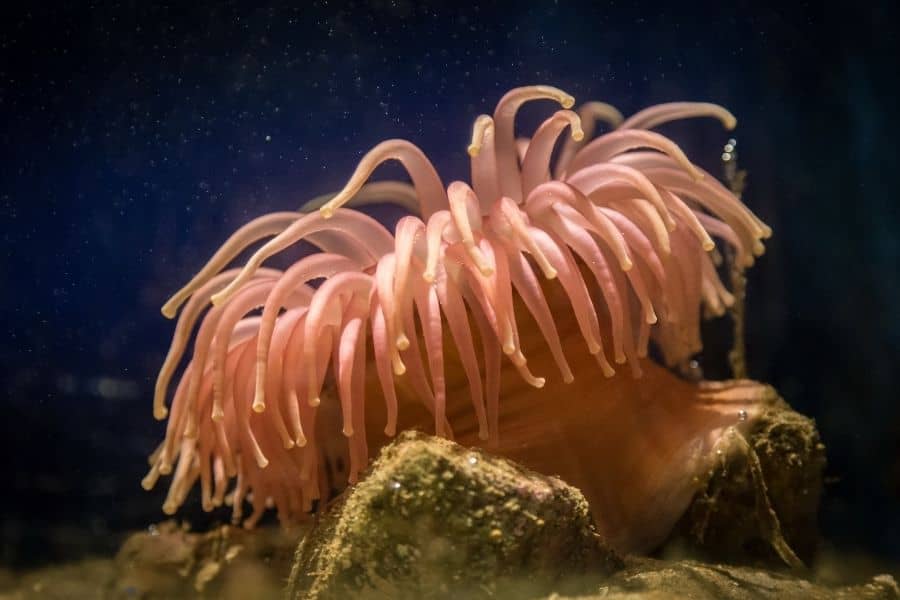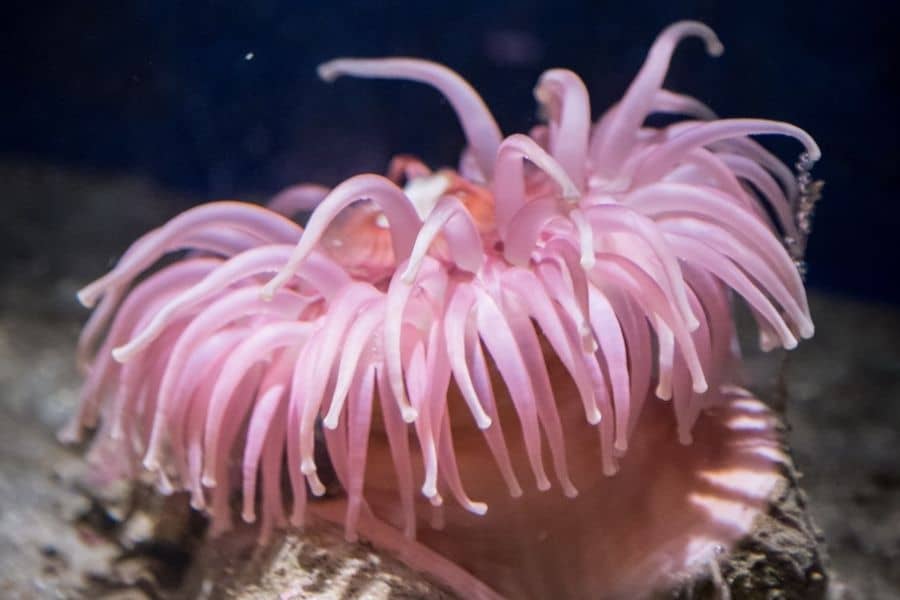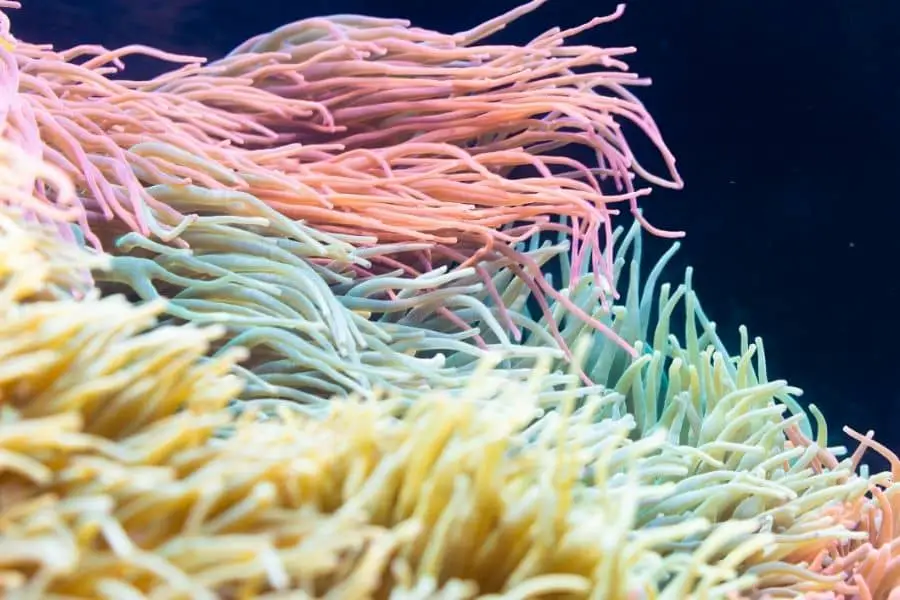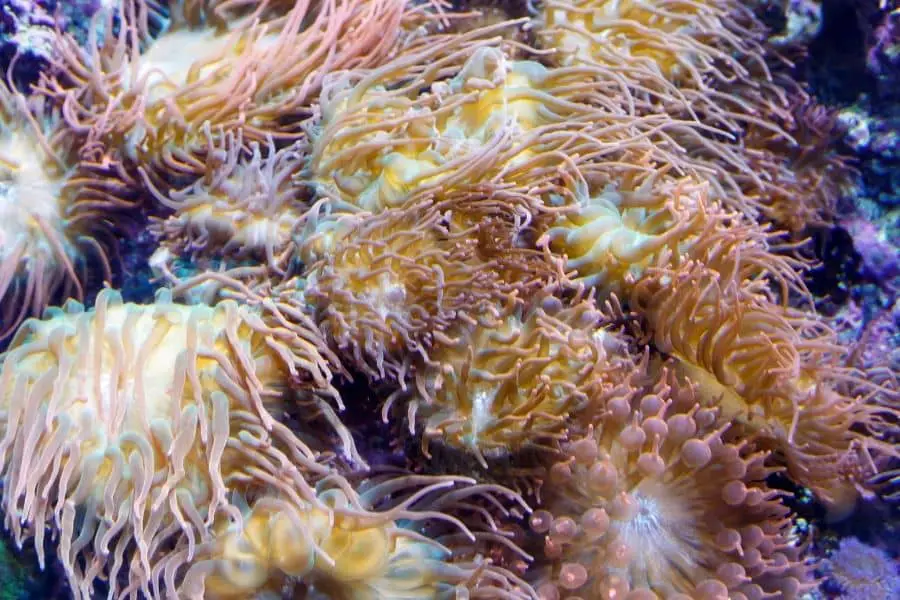Most aquarium hobbyists’ dream is a beautiful and diversified reef tank. The long tentacle anemone is one of the stunning marine creatures with a unique appearance and lovely colors. They need medium care to survive in a reef tank. Thus, I would like to share my knowledge about Long tentacle anemones care with you.

Quick Overview
Jump To
- 1 Quick Overview
- 2 One Look Care Guide
- 3 Appearance Of Long Tentacle Anemones
- 4 Long Tentacle Anemone Types
- 5 Behavior Of Long Tentacle Anemone
- 6 Long Tentacle Anemone And Clownfish
- 7 Long Tentacle Anemone Tank Mate
- 8 Tank Requirements
- 9 Special notes:
- 10 How To Place Long Tentacle Anemones In A Tank
- 11 How Long Do They Live?
- 12 How To Frag Or Propagate Long Tentacle Anemone
- 13 How Fast Do Long Tentacle Anemones Grow
- 14 What Do Long Tentacle Anemones Eat
- 15 Predators Of Long Tentacle Anemone
- 16 Is Long Tentacle Anemone Toxic?
- 17 Why Are Long Tentacle Anemones Dying?
- 18 FAQ
- 19 Source
Long tentacle anemones are also known as the corkscrew tentacle sea anemone, Sand Anemone, Red base anemone, Snaky sea anemone, and Long tentacle red base anemone. A long tentacle anemone is a species of sea anemone. They belong to the family Actiniidae. This sea anemone type is scientifically named Macrodactyla doreensis. They are commonly found in,
- West Indo Pacific from Southern Japan to Mauritius
- New Guinea to Northern Australia
- Philippines
- Eastern Indonesia
You can find them in shallow water reefs and lagoons up to 5 m or 15 feet in depth. This anemone type lives in sand or mud. Thus these substrates allow them to bury their foot. Although this anemone’s care level is moderate, they can often be found in the aquarium hobby due to their distinctive appearance and beautiful color patterns.
One Look Care Guide
| Scientific name | Macrodactyla doreensis |
| Common name | Corkscrew tentacle sea anemone Sand anemone Red base anemone Snaky sea anemone Long tentacle red base anemone |
| Care level | Moderate |
| Reef Compatible | Reef safe |
| Native to | West Indo Pacific from Southern Japan to Mauritius New Guinea to Northern Australia Philippines Eastern Indonesia |
| Color | Tentacles -White with pink tips, purple, tan, or pinkish Oral disk – Purplish-gray to brown |
| Tank size | Minimum 30 gallons tank |
| Preferred temperature | 72 to 82 oF 22.2 to 27.8 oC |
| Water Quality | Alkalinity: 8-11 dKH pH level: 8.1-8.4 Calcium: 380-430 ppm Magnesium: 1260-1350 ppm Phosphate: below 10 ppm Nitrate: below 10 ppm Nitrite: below 10 ppm Ammonia: below 10 ppm |
| Preferred salinity | 1.023-1.025 SG |
| Size | 19 inches or 48.26 cm |
| Growth rate | no exact growth rate |
| Temperament | Semi-aggressive |
| Recommended tank mates | Clownfish or anemonefish Three spot dascyllus (Dascyllus trimaculatus) |
| Preferred food | Silversides Shrimps Krill Mussels Fish Frozen carnivore preparations Other meaty items |
| Feeding frequency | 2 to 4 times per week |
| Propagation by | Sexually and asexually |
Appearance Of Long Tentacle Anemones
The body of this anemone is soft and spongy. Sometimes, an anemone’s body shape looks like a tube. When compare with other anemones, they have a basic, striated, or corkscrew pattern with long tentacles. There is a more significant space within each tentacle of these anemones than in other anemones. The tentacles are white with pink tips, purple, tan, or pinkish. All the tentacles of an anemone are the same in size and color. Tentacles can grow up to around 6 inches or 15.2 cm.

The oral disk of this anemone is purplish-grey to brown. But sometimes, it comes with a green cast. The oral disk looks like flared shape. It can grow up to around 20 inches (50.8 cm) in diameter. Further, some oral disk decorates with white lines which are oriented radially. These white lines sometimes extend onto the tentacles of the anemone.
The column of anemone is buried in the sand. The lower part of the column is dull orange to bright red, while the upper part is brownish. Their mouth is in the center of the oral disk, and usually, it is closed tightly. But the mouth will open when they feel hungry. It has an oval shape.
Long Tentacle Anemone Types
Long tentacle anemones (LTA) can distinguish based on their colors.
- Purple LTA: They have purple color tentacles
- Green LTA: They have purple, green tentacles
- Giant green LTA – These anemones have a nice green look.
- Blue LTA: They have blue color tentacles
- Ultra-LTA: These anemones have intense supper color. Their tentacles can have either one color or multiple colors.
- Yellow/green LTA: They have a mix of yellow and green color tentacles.
- Bicolor purple and green LTA: This anemone type has green and purple colors on its body, including tentacles.
- Green and white LTA: They have green color tentacles with white tips.
- Light green LTA: Its body is covered with light green color tentacles.
- Blue and white Pacific LTA: This anemone’s color type is rare and has exceptional sheer beauty. Their body is a white and blue color.
- Light blue LTA: This anemone has light blue color tentacles.
- Frozen purple LTA: They have deep purple color bodies, including tentacles with frosted white tips.
Related : Do Clownfish Need Anemones to Live?
Related : Acanthophyllia Coral Definitive Care Guide
Behavior Of Long Tentacle Anemone
All anemones, including Long tentacle anemones, belong to the semi-aggressive category. They are mobile creatures. When they move around the tank, there is a possibility to sting other fish and corals. Like other anemones, this anemone also hosts clownfish species. But it can be varied with both varieties of clownfish and anemones. Clownfish and anemones build a symbiotic relationship.
This anemones also tend to move when they do not feel happy with the environment’s current condition. In this case, you should find ‘why anemone is unhappy’ by checking the water parameters and other environmental requirements like lighting, water flow, and other factors. You should settle them in the preferable conditions as soon as possible.
If you wish to introduce more than one anemone, you should have enough large aquariums. Hence each of the anemones needs its own space. If not, it can be caused to chemical warfare among the anemones. This circumstance will cause to reduce the appetite of one anemone and shrink. Eventually, it can lead to death.

Long Tentacle Anemone And Clownfish
Anemones, including Long tentacle anemones, cannot live with most fish and invertebrates. Because when fish or invertebrates touch their tentacles, they will sting. But exceptionally, anemones host the clownfish or anemonefish. There is an outer mucus layer on clownfish. This layer covers the clown fish’s body and protects them from anemone’s toxin with immunity. Naturally, anemones and clownfish have a symbiotic relationship. Through this symbiotic relationship, both clownfish and anemone gain benefits. The main benefits are protection and nutrition.
This anemone can host the following clownfish varieties.
- Clark’s clownfish (Amphiprion clarkia)
- Pink skunk clownfish (Amphiprion perideraion)
- Saddleback clownfish (Amphiprion polymnus)
- True percula clownfish (Amphiprion percula)
- Mauritian clownfish (Amphiprion chrysogaster)
- Maroon clownfish (Premnas biaculeatus)
Special Note: They should be 3 to 4 larger in diameter than the length of the clownfish. For example, a 4 to 6 inches anemone is better for a 1 to 1.5 inches clownfish. Also, it would be best if you placed a Long tentacle anemone before adding the clownfish into the aquarium. Give a few months to your Long tentacle anemones to adjust to the new environment and settle. After that period, put clownfish into your tank.
Long Tentacle Anemone Tank Mate
Usually, fish and invertebrates do not prefer to live with Long tentacle anemones in the same tank except for a few clownfish varieties because anemones tend to sting and prey on the fish and invertebrates. Anyhow, you can diversify your anemone tank by adding the following species.
- Three spot dascyllus (Dascyllus trimaculatus)
- Clark’s clownfish (Amphiprion clarkia)
- Pink skunk clownfish (Amphiprion perideraion)
- Saddleback clownfish (Amphiprion polymnus)
- True percula clownfish (Amphiprion percula)
- Mauritian clownfish (Amphiprion chrysogaster)
- Maroon clownfish (Premnas biaculeatus)
Tank Requirements
You should provide an ideal environment for the Long tentacle anemone to live happily and healthily. Because if you carefully consider the tank requirements of the anemone, you can complete about 80% of the satisfaction of the anemone. When you rear the Long tentacle anemone, you should consider about following factors.
- A long tentacle anemone needs at least 4 inches of sand or mud to settle. These substrates help the anemone to anchor its foot to the hard surface.
- Do not recommend crushed coral because it can lacerate the anemone’s foot.
- Live rocks support create a comfortable environment for the Long tentacle anemone. Not only this but also:
- Live rock is an excellent biological filter for your anemone aquarium
- It is an ideal base to attach the Long tentacle anemone
- It would be best if you covered all the pumps in the aquarium. Generally, quality pumps have a guard.
- Well-grown Long tentacle anemone can produce a binload similar to the number of 4 or more fish’s wastes. Therefore, it is highly recommended to install a good filter system in the aquarium.
Size of The Tank
The minimum space requirement for a Long tentacle anemone is 30 gallons. But it is a highly recommended large tank because they need their own space to live happily and healthy. Nano tanks are not recommended for Long tentacle anemones.
Water Quality
There are several parameters that you should keep stable in your tank.
- The pH level of water: The ideal pH level should be between 8.1 to 8.4 because sea water contains this pH level.
- Calcium level of water: Another critical component is calcium, and it should be between 380 to 430 ppm.
- Magnesium level of water: You should maintain a magnesium level between 1260-1350 ppm.
- Alkalinity level: It is an important parameter. You should maintain an alkalinity level in between 8-11 dKH.
- Water Temperature: You should maintain the water temperature between 72 to 82 Fahrenheit or 22.2 to 27.8 Celsius. You can install an aquarium heater to temperate at a stable level.
- Salinity level of water: The ideal salinity level should be between 1.023 to 1.025 specific gravity for long tentacle anemones.
- Nitrate level: The nitrate level should maintain below ten ppm. Always try to reduce the nitrate level to zero because it is toxic to the clownfish and anemones.
- Phosphate level: It is highly recommended to keep the phosphate level below ten ppm.
- Ammonia level: The ammonia level should be maintained below ten ppm.
Special notes:
Recommended dosing pump helps to keep the water quality in your tank. The dosing pump can alleviate the manual dosing of the water with calcium, alkalinity, and magnesium 2-4 times a week. Alternatively, you can also use Purigen and Poly-fiber to keep the quality of your aquarium water. It is better to check and adjust the magnesium level before you use the calcium test. Try to maintain the minimum level of nitrate, nitrite, ammonia, and phosphate level. A better filter system is an added advantage to achieving good water quality.
Water changes also play a vital role in stable water conditions.
| Bi-monthly | 10% water change |
| Monthly | 20% water change |
You should perform a water change once either nitrate, nitrite, ammonia, or phosphate level exceeds ten ppm.
Flow Rate
Long tentacle anemone requires moderate water flow. The long tentacle anemone away from direct water flows because they like subtle movements. Thus you should adjust the powerhead accordingly.
Lighting
Long tentacle anemones like life in an area with moderate lighting conditions (PAR 180-280). It is a better 14-20 K color spectrum for good coloration.
How To Place Long Tentacle Anemones In A Tank
Before placing them, you should follow the acclimation process. It helps to adjust anemones to the new environment and reduce stress. The floating or dip method is better to acclimate the long tentacle anemone. Turn down the flow rate of your aquarium. Then dig a hole in the sand bed. When choosing a place, you should leave 3 cm and 5 cm space between anemones and corals. Then place the long tentacle anemone in it. After that anemone in a comfortable place, you can increase the water flow to a preferable level. Keeping the water condition stable and feeding them properly.
Special note: You should provide adequate space for the long tentacle anemone. When handling Long tentacle anemone, it is recommended to wear gloves. When placing a long tentacle anemone, do not use tongs.
How Long Do They Live?
Unfortunatly, the life span of the Long tentacle anemone is not discovered yet. In the wild, they can live hundreds of years. But in captivity, the life span of a Long tentacle anemone is around 80 years. But you can increase their lifespan by providing the best care.
How To Frag Or Propagate Long Tentacle Anemone
Generally, breeding Long tentacle anemones is difficult in captivity. Long tentacle anemone propagates or frags sexually and asexually.
Sexual Propagation
Sexual propagation is the same as other species. Basically this Long tentacle anemones create swimming lava by combining sperms and eggs. In captivity, sexual propagation happens very rarely.
Asexual Propagation
Evidently, fission is the asexual method that use to propagate long tentacle anemones. Similarly Long tentacle anemones can split into two different anemones. Also you can motivate long tentacle anemones to split by feeding them properly. You can feed them frequently. Also, they tend to split due to stress.
Chiefly long tentacle anemones use the splitting process for self-preservation. In captivity, you can propagate them artificially. Besides you can cut half of the anemone’s body and place them under preferable conditions. It would be best if you choose a healthy anemone to propagate artificially.
How Fast Do Long Tentacle Anemones Grow
Long tentacle anemones can grow up to 19 inches or 48.26 cm. But there is no exact growth rate. You can rear a healthy and well-grown log tentacle anemone by providing the best care. You can provide a better environment to optimize long tentacle anemone growth. Thus, you should consider the following facts carefully.
- Preferable water parameters
- Lighting conditions
- Water flow
- Quality feeds
- Eliminate the stressful factors
What Do Long Tentacle Anemones Eat
Like other anemones, the Long tentacle anemone is a carnivore. Therefore, they are fond of meaty foods.
In the wild,
- Long tentacle anemones collect daily required nutrients through their symbiotic algae, zooxanthellae.
- They catch prey by their venomous cells or nematocysts in their tentacles.
- Long tentacle anemone can collect nutrients dissolved in the water
- Also, this anemone consumes the waste of resident fish like clownfish or anemonefish.
- Long tentacle anemone has the opportunity to eat an excess chunk of foods of clownfish.
In captivity,
you can feed them by using the following foods.
- Silversides
- Shrimps
- Krill
- Mussels
- Fish
- Frozen carnivore preparations
- Other meaty items
How To Feed Them
- Take a small cup and fill it with aquarium water.
- Soak the food that you select to feed the anemone
- Wait about 20-30 minutes until it softens.
- Provide the food by using a stick or tweezer.
- Anemone grabs the food from their sticky tentacles.
- Do not poke the stick or tweezer into the anemone. It can damage the columns of an anemone.
Feeding Frequency
You should feed your Long tentacle anemone 2 to 4 times per week. You can generate a colorful and healthy anemone by fulfilling its nutrient requirements properly.
After Feeding
To keep a tank free from byproducts like ammonia, nitrate, and nitrite, you should remove the excess foods from the aquarium. If you allow them to decay in the tank, it will cause to reduce the water condition, and poor water conditions can damage the Long tentacle anemones.
Predators Of Long Tentacle Anemone
- Nudibranchs (Nudibranchia)
- Angelfish (Pterophyllum)
- Sea stars (Asterias rubens.)
- Crown-of-thorns starfish (Acanthaster planci )
- Bristle worms (Polychaeta)
- Other anemones (Actiniaria)
Special note: In addition to these species, if you wish to add another species to your anemone tank, you should have well aware of the particular species.
Is Long Tentacle Anemone Toxic?
Most probably, sea anemones are harmful to humans. Several toxins can consist in their body. Sea anemones, including Long tentacles anemones, have venomous cells or nematocysts in their tentacles. Therefore, when you handle the Long tentacles anemone, you should wear gloves. Try always to minimize the handling of them.
Why Are Long Tentacle Anemones Dying?
Few factors can kill your Long tentacle anemones. It would be best if you kept in mind the following facts when rearing the anemones.
- If you have two or more anemones in your tank, you should arrange enough space for them. If not, it can be caused to chemical warfare. As a result of this, one anemone refuses the food, and eventually, it can die.
- Diseases can paralyze the Long tentacle anemones. You can prevent it by providing quality water conditions and quality foods.
- Due to the poor lighting condition, Long tentacle anemones are bleaching. This case happens by expelling the zooxanthellae.
- Predatory activities can kill the Long tentacle anemones.
- If you do not follow acclimating process, an anemone can be stressed and die.

FAQ
Will Clownfish Host Long Tentacle Anemone?
Yes. There are several clownfish or anemonefish varieties that host Long tentacle anemones. These are:
- Clark’s clownfish (Amphiprion clarkia)
- Pink skunk clownfish (Amphiprion perideraion)
- Saddleback clownfish (Amphiprion polymnus)
- True percula clownfish (Amphiprion percula)
- Mauritian clownfish (Amphiprion chrysogaster)
- Maroon clownfish (Premnas biaculeatus)
The above species can maintain symbiotic relationships with long tentacle anemones. This symbiotic relationship gives benefits to both parties. Generally, this relationship is based on their feeding behaviors and protecting behaviors.
Are Long Tentacle Anemone Reefs Safe?
Yes. Long tentacle anemone is reef safe. But when placing anemones, you should arrange adequate space for them. It is better to leave about 5 cm between anemone and corals. If you do not provide enough space for them, the anemone will show aggressive behaviors.
Can Clownfish Live Without Anemone?
Yes, clownfish can thrive without anemones, especially in aquariums, because aquarists do not keep predators with them. In the wild, the symbiotic relationship plays a significant role in fulfilling the protection and nutrient requirements. Thus, in captivity, the aquarist should concern about these two factors carefully. Quality foods can increase the clown fish’s life span.
Related : Bubble Tip Anemone (Entacmaea quadricolor) 9 Important Facts
Related : Rock Flower Anemone | Beautiful Rock Flowers
